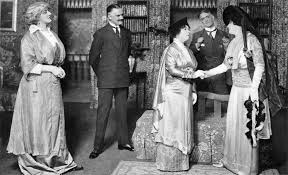Giving Men
0 comment
Professor Henry Higgins, in My Fair Lady, the wonderful musical version of George Bernard Shaw’s Pygmalion, sings a wonderful lament that is still funny today: “Why Can’t a Woman be More Like a Man?” But in the world of charitable giving, the refrain should be: why can’t men be more like women? Well, maybe with a little subterfuge from a new study, we can make that happen.
It is well established in the annals of academic research that men are less likely to give of their money and their time to charitable causes. (Men, if you don’t like the facts, change them). As recently as five years ago, the 2010 Women’s Philanthropy Institute Report (the most recent study they’ve done on this) found that single female headed households gave 57% more to charity than single male headed households. This despite the fact that, according to 2013 US Census data, female headed households had household incomes approximately 70% of that of male headed households, regardless of whether these were households with children.
It is also well documented that when men do give, they give very differently from women. First, according to financial and tax advisors, men generally give for the tax advantage and for self-interest, whereas women give to help, nurture and improve everyone’s quality of life. Second, according to the same survey mentioned above, women give more, and more often than not twice as much more, than men, holding true at almost every income level. And third, men are less empathetic, once again well established by academic research, while women have a higher quotient of empathy and compassion, leading men and women to give to different causes. Thus, women tend to give far more money than men to organizations that help the underserved—social service organizations, poverty reduction organizations, literacy organizations, etc.
Now, a group of researchers coming out of Stanford and Columbia Universities have taken a look at trying to understand whether there is a way to change this great differential and make men more willing to give to causes that help the poor—and it doesn’t involve jerry-rigging their DNA. These researchers are looking at the thinking that the differences in giving aren’t necessarily rational (i.e., men believing it is government’s job to take care of the poor, while women believe it is everyone’s), but rather emotional. As research has demonstrated again and again, men simply don’t tend, in same degree as women, to the prosocial emotions of compassion and caring–emotions that motivates giving to help others. Specifically, this research is looking to determine if there is a particular “pitch” that will overcome men’s lack of empathy for poverty issues by positioning poverty as something that impacts everyone, thereby appealing to the self-interest that research has found motivates men’s giving.
The researchers tested five different scenarios for framing the description of the nait-poverty organization before asking for a donation of money and of time. Four scenarios loaded the description toward one each of well-documented understandings about what motivates people to give, while the fifth was the neutral. The four understandings are:
- Conformity: people give because they see others giving
- Efficacy: people give because they believe there will be a measurable impact resulting from that giving
- Clear injustice: people don’t give because they deeply believe that the world is just and fair, and suggestions to the contrary are explained away in support of the view that all is right in the world
- Self-interest: people only give when there is a clear path between the cause and benefit to self.
The survey questions were embedded in a much larger, internet survey. Almost two-thirds (63.3%) of the 1,715 invitees completed the survey. Respondents were asked: one standard question for assessing empathy; one description of an hypothetical anti-poverty nonprofit (that respondents did not know wasn’t a real nonprofit) with five different spins—one for each of the four approaches above (such as, “When you give to CRP, your donation addresses a problem that hurts us all,” addressing the thinking that giving is a result of seeing an alignment between self-interest and giving) and one control description; one question each on the respondent’s willingness to give a $10 donation and volunteer; and questions about their views on poverty.
Overall, regardless of the scenario, men were significantly less likely than women to say they would give money to and volunteer with this poverty organization. But when the researchers controlled for empathy—in other words, neutralized the differences between men’s and women’s levels of empathy—the differences in men’s and women’s willingness to give money or volunteer disappeared.
But the finding from which we can learn the most is the following: of all of the different scenarios, the one that played to a person’s self-interest had a significant and positive influence on men’s willingness to give, and a negative, but insignificant, influence on women’s wiliness to give—meaning that by telling men that giving to the anti-poverty nonprofit would help them, because poverty affects everyone, including them–men were more willing to give. (There was not the same impact on volunteering: there was no significant relationship between a self-interest motivation and willingness to volunteer for men, yet there was a negative, and significant, impact on women’s willingness to volunteer.)
Thus, if you want your male donors to be more like women and give more to your cause (and there is reason to believe that this applies to more than just anti-poverty nonprofits), connect your cause to their self-interests. But remember: women aren’t like men and don’t use the same tactic with them. It may just backfire.
The opinions expressed in Nonprofit University Blog are those of writer and do not necessarily reflect the opinion of La Salle University or any other institution or individual.

